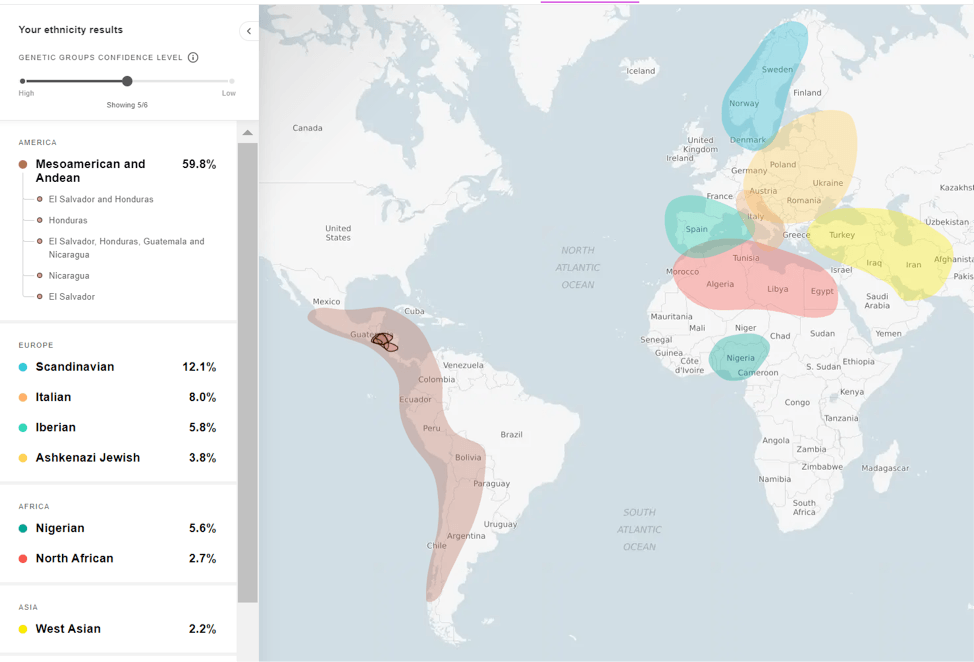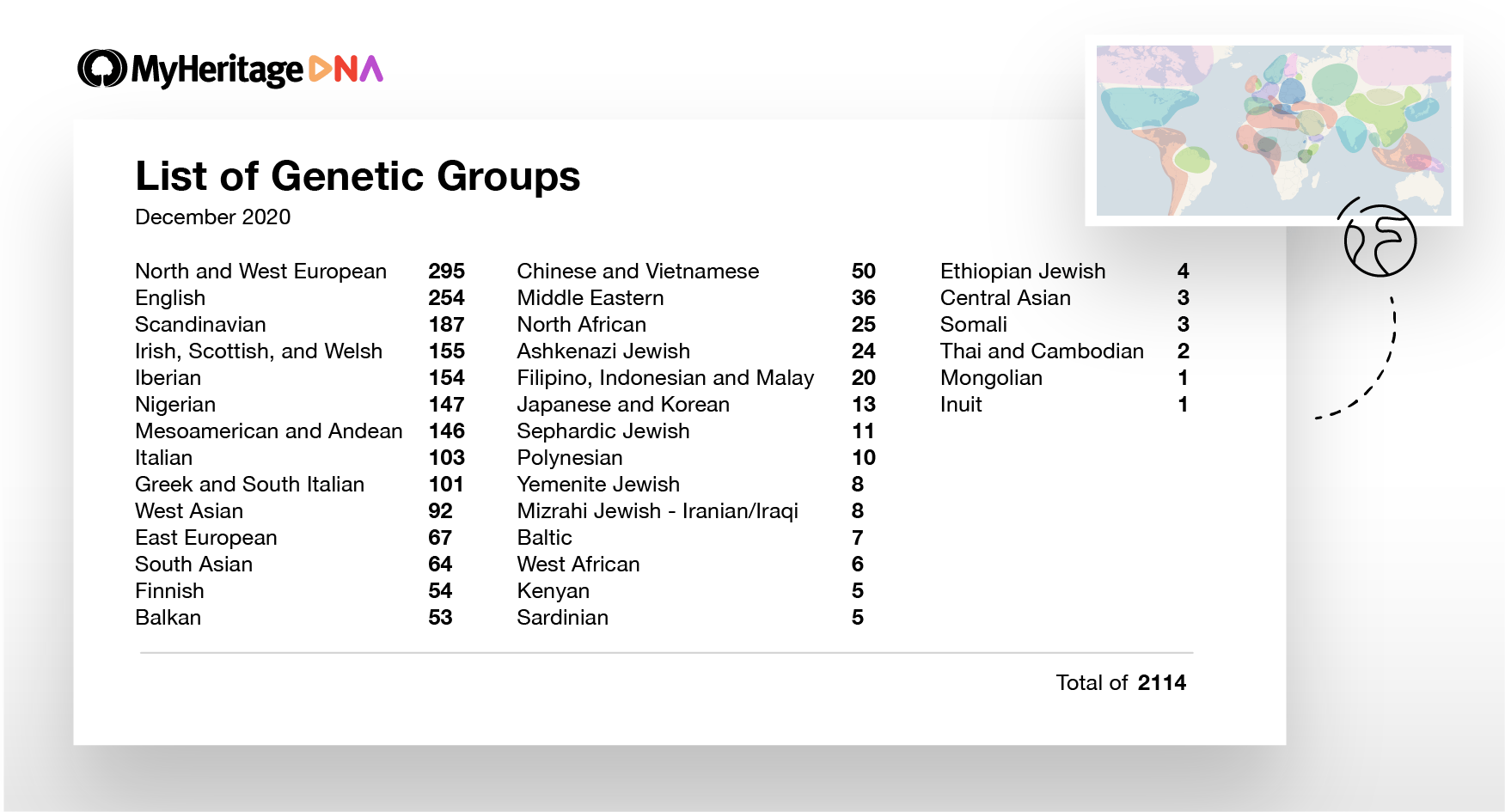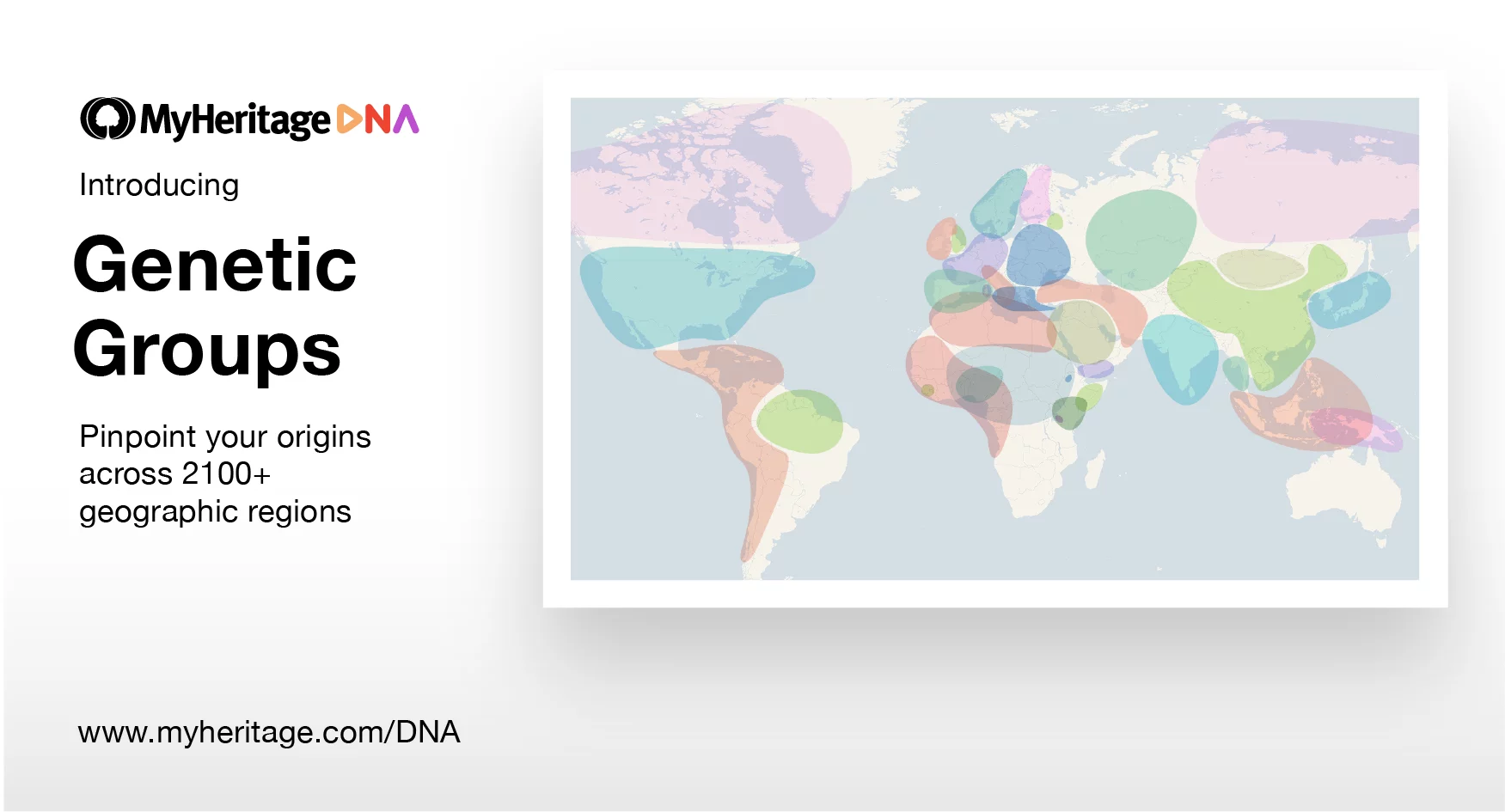
Genetic Groups break down MyHeritage’s ethnicity results into 2,114 geographic regions, providing more depth and resolution than any other DNA test available today. These results allow you to zoom in on your family history, pointing to specific provinces, districts, or regions that your ancestors came from.
Below, you can see how many Genetic Groups are available for each one of the 42 ethnicities currently supported by MyHeritage DNA. For example, there are 103 Genetic Groups that are predominantly Italian, and 54 groups that are Finnish:
For each Genetic Group, MyHeritage provides a drill-down page with detailed genealogical insights. It includes a description of the group, a heatmap showing the top places where the group’s members lived during different time periods (indicating the group’s migration patterns), common ancestral surnames and given names in the group, the most prevalent ethnicities among the group’s members, and other Genetic Groups that have close affinity to the group. Users can review this information not only for Genetic Groups that they have been found to be members of but also for any of the other Genetic Groups on MyHeritage.
Genetic Groups are fascinating and can offer insights into the paths your ancestors traveled over generations. They can point to a province, district, or region that your family originated from or show migration from one location to another, and often tell you more about the family story.
Genetic Group Founder Populations
Genetic Group Founder Populations are groups of people who lived in the same area for centuries, only marrying within that group, or perhaps migrating as a group. Over time, they formed unique genetic signatures.
The descendants of these founder populations have telltale DNA segments that they inherited from the group’s founding fathers and mothers. The MyHeritage DNA test detects these signatures, and by identifying millions of DNA microsegments and pinpointing to which Genetic Groups those segments belong, our research teams have been able to associate MyHeritage DNA users with those Genetic Groups.
Genetic Groups differ from Ethnicity Estimates, in that a particular group can be comprised of one or several ethnicities. Members of a group share geographic origins, but they may have members who come from diverse ethnic backgrounds. For example, a Genetic Group in Australia may consist of individuals whose ancestors originated in England and Germany, but after migrating to the same city became a melting pot and created a new group of their own.
Being a member of a Genetic Group does not come with a percentage; you are either a member of the group or you are not. If you are a member of a Genetic Group, it means that we found a sufficient number of segments in your DNA that associate you with that group.

Each Genetic Group in which you are considered a member is assigned a confidence level based on your DNA segment information. Being a member of a Genetic Group with low confidence can still be very interesting and it means that you are more distantly descended from that group.
You may be a member of several Genetic Groups because you may have inherited DNA from the founding fathers or mothers of multiple Genetic Groups. While the vast majority of our users will see one or more Genetic Groups in their results following this release, some users won’t receive any Genetic Groups in their results, either because they are descendants of ethnicities or groups that rarely use MyHeritage, or because their membership confidence levels were below our thresholds. This is our first release of Genetic Groups and we plan on improving them significantly in the future, adding more data, and providing more resolution, so there will be more groups of higher quality later on.
Accessing Genetic Groups on MyHeritage
To see your Genetic Groups, go to the “Ethnicity Estimate” section under the DNA tab on the navigation bar. We will also send an email announcement to every user with a DNA kit on MyHeritage, inviting them to view their Genetic Groups.
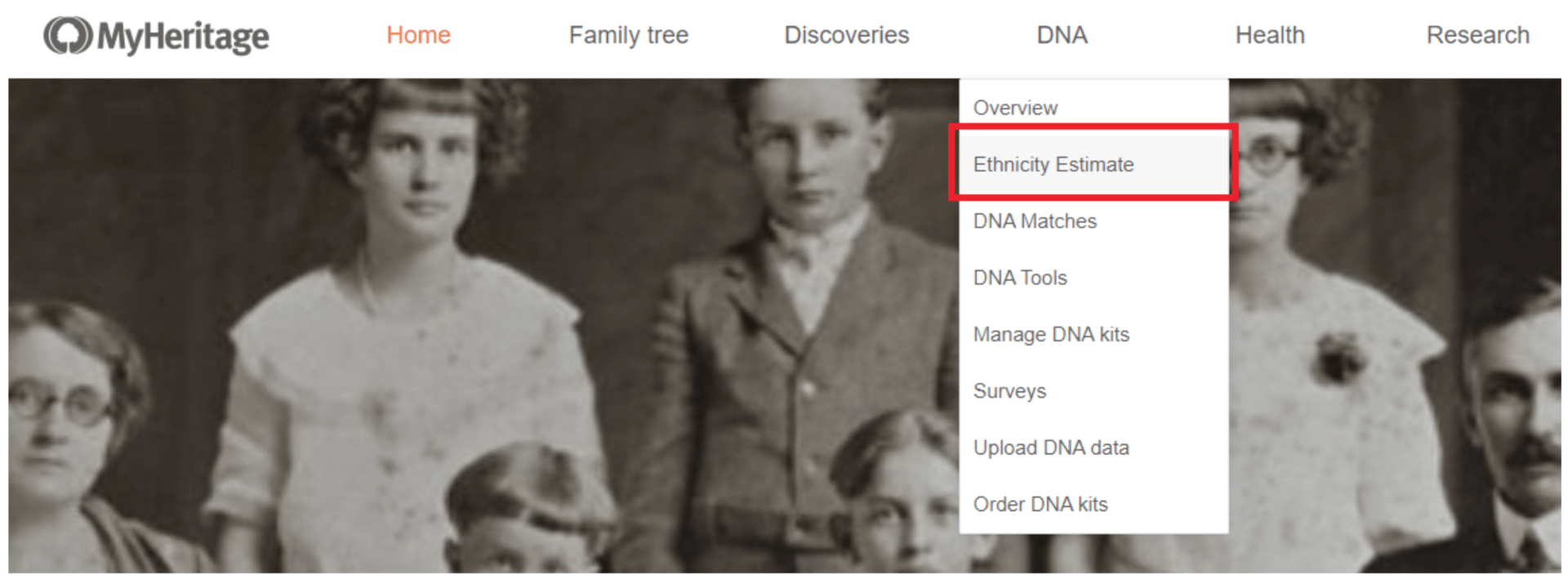
Genetic Groups are part of the Ethnicity Estimate in the DNA results, complementing the 42 high-level ethnicities with percentages. The high-level ethnicities have not changed in this update, but the Ethnicity Estimate page itself has a new and improved user interface. If you have Genetic Groups, they will appear nested under your ethnicities in the left-hand panel.
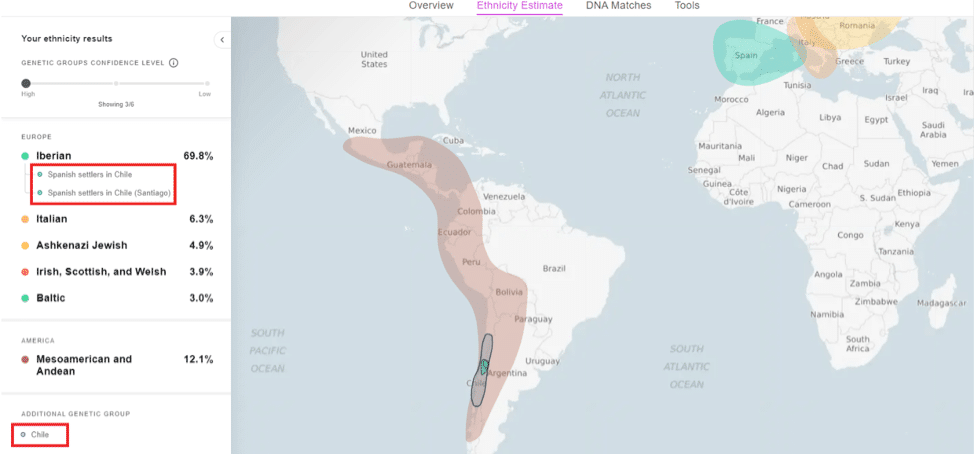
If a Genetic Group seems to have a prominent ethnicity for its members and the user has that ethnicity prominently too, the Genetic Group will be nested below that ethnicity in the results. Otherwise, it will be listed separately at the bottom under the heading “Additional Genetic Group(s)”.
If you manage multiple DNA kits, you can easily switch from one to the other by using the drop-down menu next to your name at the top of the page.
Genetic Groups are displayed on the map as polygons with a thin border around them (as opposed to the ethnicities which are displayed without borders). In the example below, the user received an ethnicity result of 97.7% “Japanese and Korean”, but one of the Genetic Groups under it provides a much higher resolution.
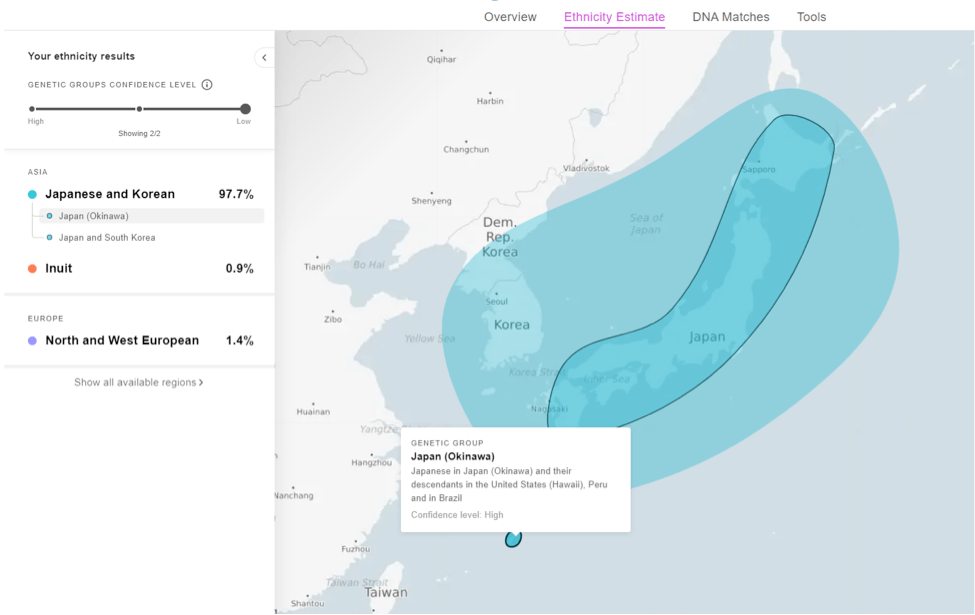
You may be a member of several Genetic Groups. If you hover over the names of the Genetic Groups on the left panel, or the polygon for that group on the map, you will also see a description and the confidence level for that group.
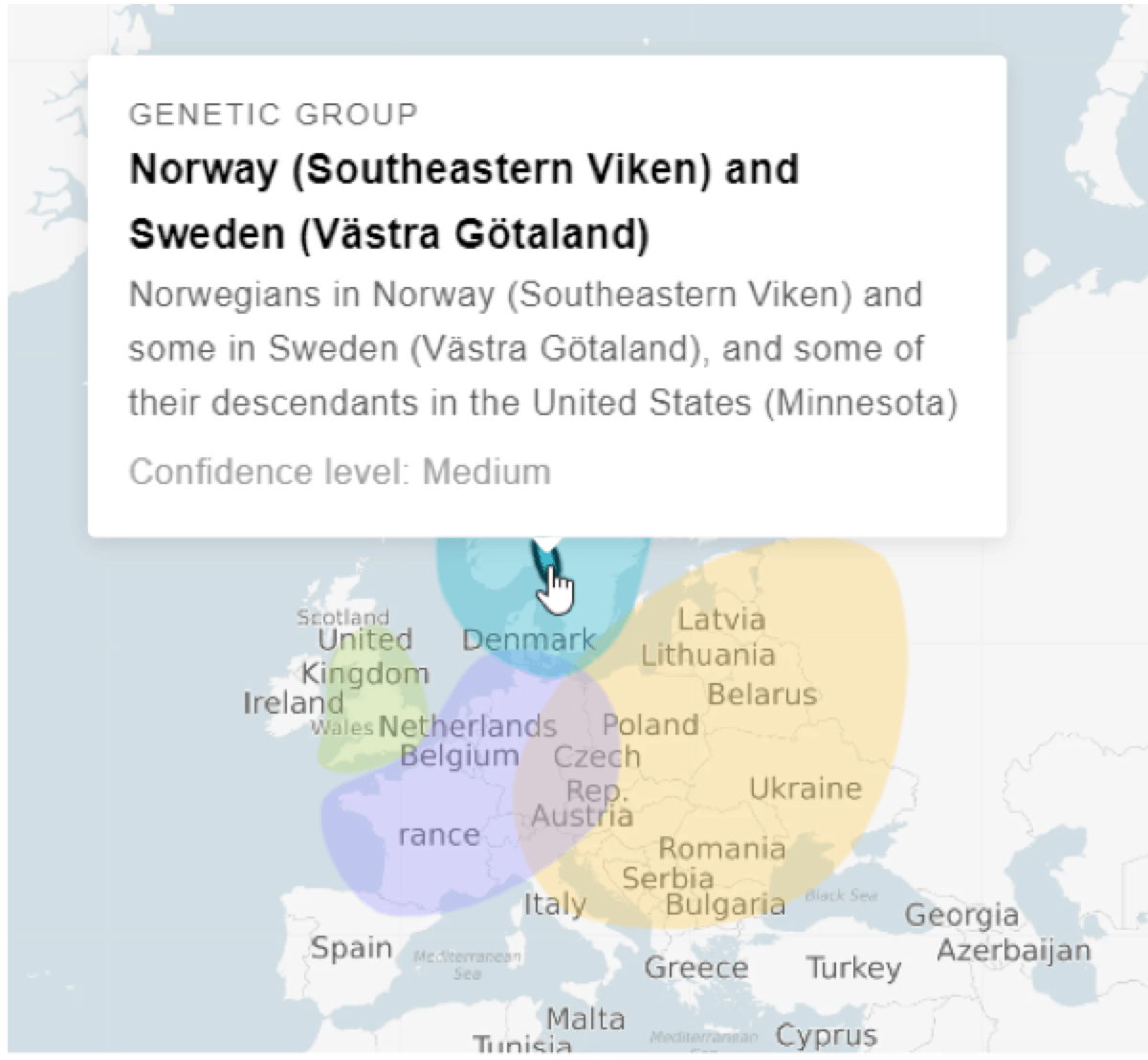
Confidence Slider
The new interface includes a helpful confidence slider above the list of ethnicities that allows you to select the confidence level of the Genetic Groups displayed for your DNA kit.
When you choose a level, we will display your Genetic Groups that are equal to or above that confidence level. There are three confidence levels: low, medium, and high. The default confidence level is the highest confidence level that displays at least three Genetic Groups.

If you choose low, you will see all Genetic Groups you are a member of, without discretion. If you choose medium, you will see Genetic Groups that you are a member of with medium to high probability. If you choose high, then you will only see Genetic Groups that you have a high probability of being a member of. In the above example, the default level of medium shows 4 out of 6 Genetic Groups. Moving the confidence level to low shows all 6 groups that this user belongs to, and moving the confidence slider to high shows only 1 of the 6 groups.
The confidence level is dependent on the quality and quantity of the segments that you share with the genetic data that represents each group. We have algorithms in place to assign each group in your results with the confidence level that determines the probability that you are part of that group. Since this analysis is segment based, we are contemplating showing these segments that associate you with a particular Genetic Group in the Chromosome Browser on MyHeritage in the future.
In some cases, where all Genetic Groups have the same confidence level, we will not display the confidence slider. For example, if you have four Genetic Groups, and all are medium confidence level, then we will not display the confidence slider above your ethnicity results, as it will be redundant.
Hierarchy of Genetic Groups and Ethnicities
Genetic Groups utilize a personalized hierarchy. This means that each Genetic Group that you are a member of will be nested under an ethnicity that best fits that Genetic Group and your own DNA results.
For example, the Genetic Group of Malta has a mix of Italian and North African heritage. If you are a member of the Maltese group, and have a large percentage of Italian ethnicity, the Maltese group will be nested under your Italian ethnicity. However, if you’re a member of the Maltese group and have North African heritage but no Italian origins, in this case the same Genetic Group will be nested under North African ethnicity.
In the example below, 5 high-confidence Genetic Groups were nested under the ethnicity Irish, Scottish, and Welsh, which is this user’s primary ethnicity:
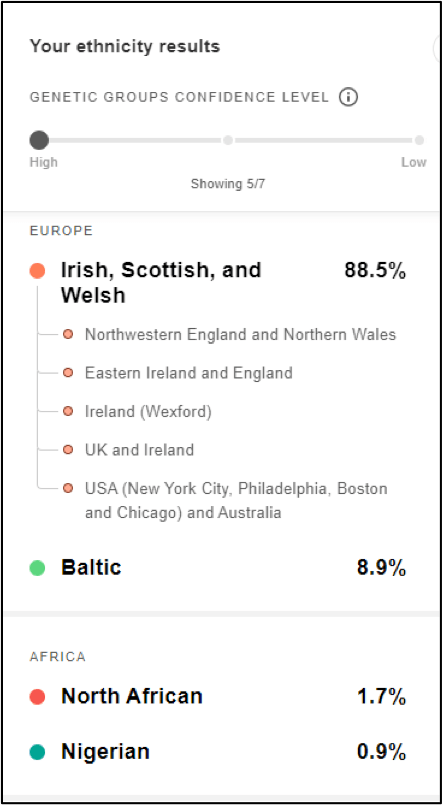
If there is no predominant ethnicity that you share in common with a Genetic Group, it will be placed under a new category at the bottom of your Ethnicity Estimate results, called “Additional Genetic Groups” (or “Genetic Groups” if all your groups are listed there).
We will only place your Genetic Groups under a specific ethnicity if we are confident that it belongs there. For example, if you are part of the Maltese group, and you have very similar ethnicity percentages for both Italian and North African ethnicity (which are both common to this Genetic Group), then we cannot determine which one is more appropriate for the Genetic Group to be placed under, and instead your Maltese Genetic Group will appear under “Additional Genetic Groups”.
Genetic Groups are tied to a population rather than to any one ethnicity, and within that population there can be multiple ethnicities. Please note that the placement of a Genetic Group does not necessarily explain why you are a member of that group, and once ethnicities on MyHeritage are refined (see more on that below), the placement of the Genetic Group might change in your results.
Additional information about each Genetic Group
In addition to listing the Genetic Groups to which you belong, MyHeritage provides a drill-down page with additional genealogical insights about each group, including the top places its members lived during different time periods throughout the past few centuries, common ancestral surnames and given names, common ethnicities among the group’s members, and more.
Click on any Genetic Group’s name in the left-hand panel or on the polygon of the Genetic Group on the map, and a detailed page will display more information about that group. The default time period is 1900–1950 and you can select other time periods as you wish.
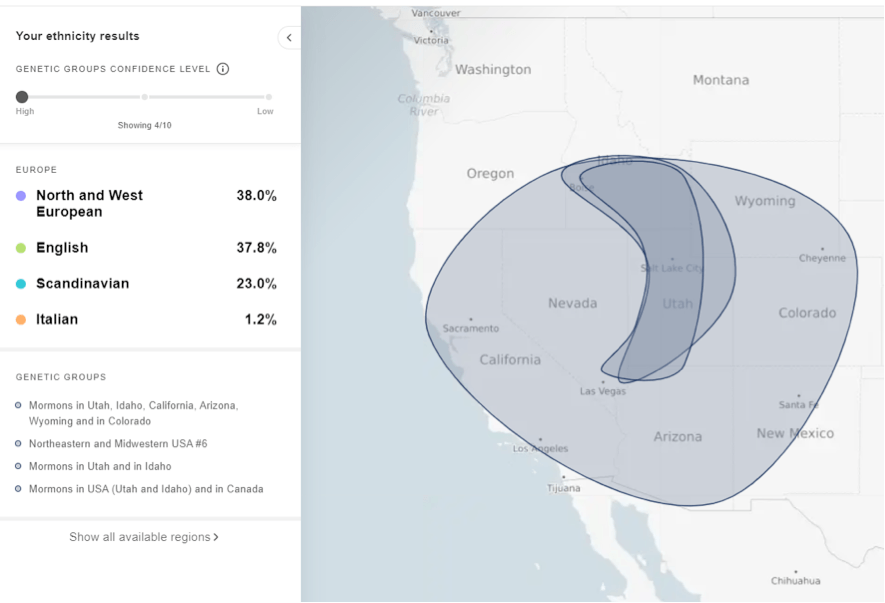

Use the arrows above the group name to move from group to group in your results.
Let’s drill down further to see what information is included in this page.
About this group
Under the group name, the description of the group is displayed.
You will also see the number of DNA kits used to form the group, and the number of DNA kits which were linked to family trees. The number of reference kits used to define each Genetic Group can help you understand which groups are more common among MyHeritage users. While some groups are large and based on thousands of kits, others are more exotic and are based on a small number of kits. Both can tell an equally compelling story, and be interesting to examine further.
Under that, the confidence level for this group will be listed in your results .
Check the “Expand all” box to show all the data that we have for each of the categories.
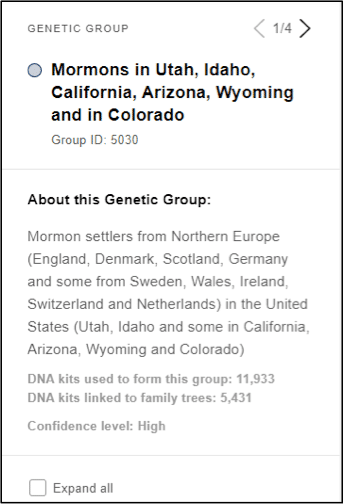
Top Places
This section shows countries and cities around the world where members of the Genetic Group lived during a specific time period. You can drill down to view the group’s precise whereabouts during different time periods from the 17th century until today. This section corresponds with the map on the right which displays these places.
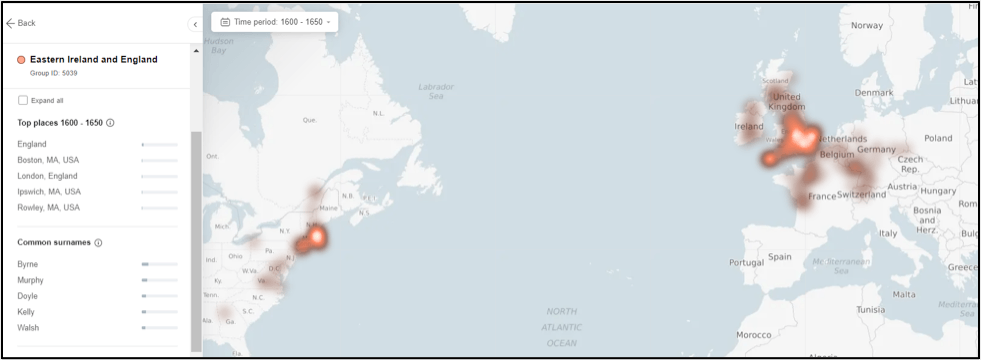
Use the “time period” selector above the map to see different distributions of places, both in the list on the left and on the map, for different time periods.
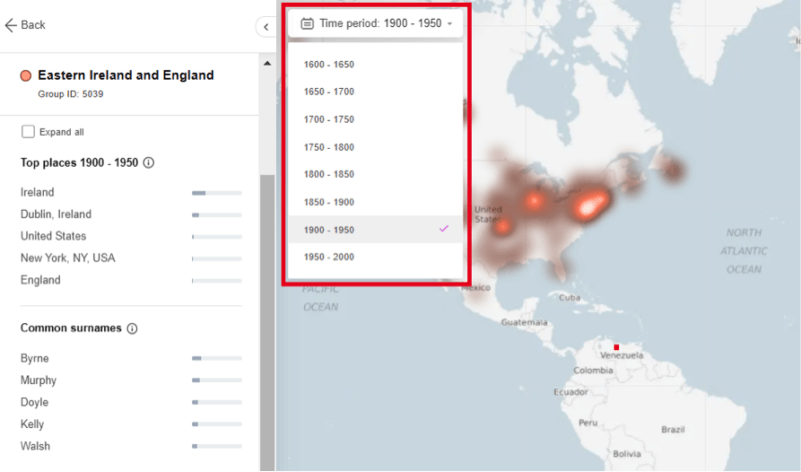
We plan to improve the list of Top places in the next few weeks so that it will have a more organized hierarchy and countries will receive more accurate “votes” from the cities beneath them, so that this section in the page will provide more useful information.
Common surnames
Members of Genetic Groups often have distinctive ancestral surnames that tell a lot about the group’s identity. If you have any of those ancestral surnames in your family tree, it may further corroborate your link to the group. The bars indicate how common these surnames are in the family trees used to form this group.

Common given names
Members of Genetic Groups can often have distinctive given names. The bars indicate how common these given names are in the family trees used to form this group.

Common ethnicities
Each Genetic Group consists of individuals from one or more ethnicities. It can be interesting to see which groups contain fewer ethnicities and are more homogeneous, and which are more mixed. The bars indicate the ethnicities common among the DNA kits used to form this group.
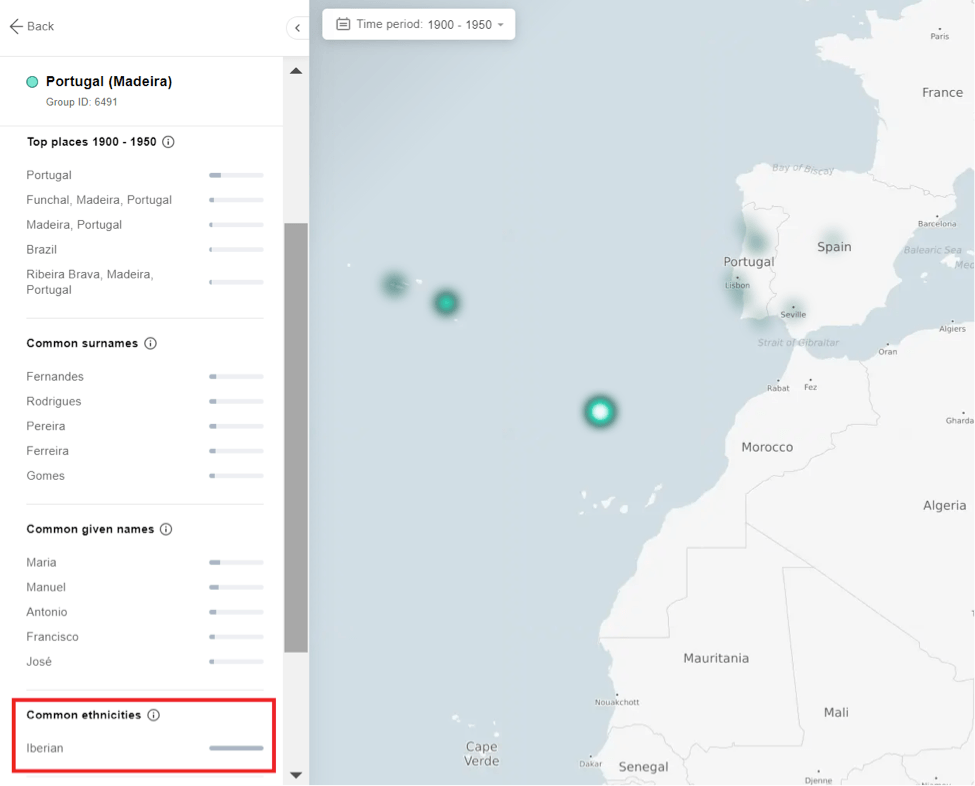
Related groups
These are groups that have a strong affinity to the Genetic Group you are currently viewing. Each related group may have genetic similarities to your group due to geographic proximity and potential marriage between members of the two groups over generations.
Any related groups listed that you are also a member of are displayed with a colored icon. The related groups that you are not a member of will be shown with a grey icon.
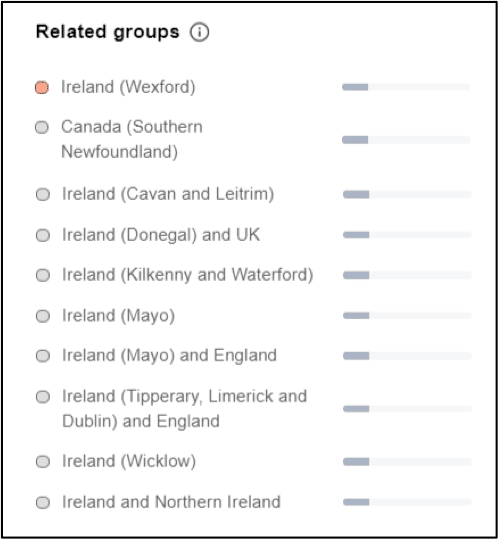
Exploring all Genetic Groups
You can explore all 2,114 Genetic Groups on MyHeritage, including all those that you are not a member of. To do so, click “Show all available regions” at the bottom of the left-panel in the Ethnicity Estimate page. MyHeritage will then list all available Genetic Groups, beneath an ethnicity hierarchy, displaying how many Genetic Groups are found under each ethnicity.
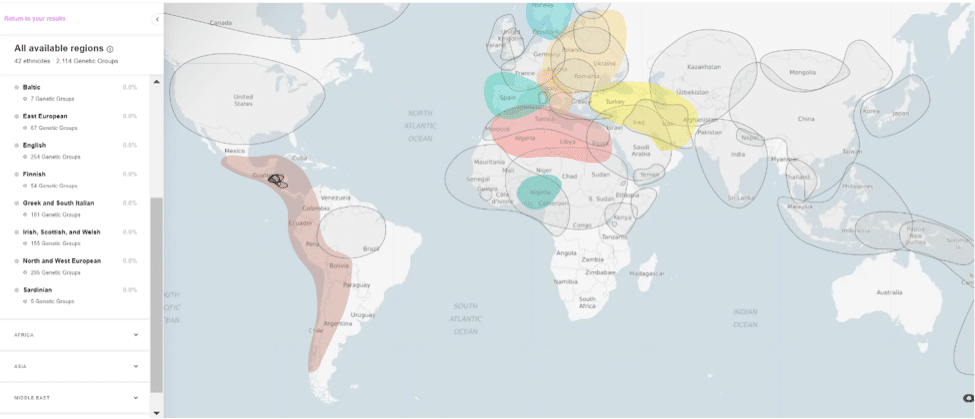
Next, click any of the ethnicities listed. MyHeritage displays it in an enhanced page that includes a representative image (this is new in this update). Then the page will list the Genetic Groups you have under this ethnicity (if any) and further on, all Genetic Groups will be listed. Click any of them to explore it. You may just hover the mouse over it to get a description tooltip and see its main polygon on the map.

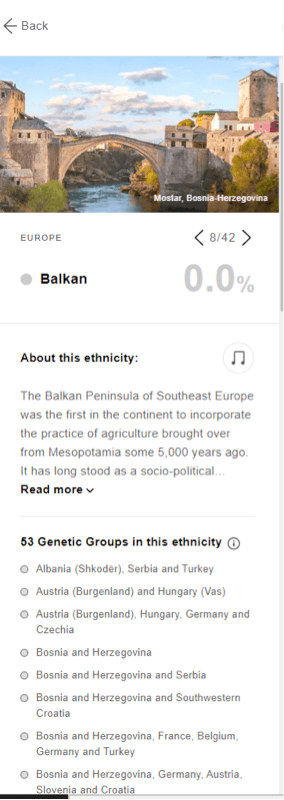
You can click the sound icon to play a short and sweet original tune that we composed for each ethnicity to get a taste of its culture.
Eligibility
Genetic Groups are available for free to anyone who has already tested with MyHeritage DNA. They have been rolled out to all our users in the Ethnicity Estimate page.
If you tested with another service and uploaded your DNA results to MyHeritage before December 16, 2018, you were grandfathered in and have free access to advanced DNA features forever, and you will be able to view Genetic Groups for free under your Ethnicity Estimate.
If you uploaded your raw DNA data to MyHeritage from another testing service after that date, and do not currently have access to the Ethnicity Estimate, you may pay a one-time unlock fee of $29 per kit and gain full access to advanced DNA features (AutoClusters, Theory of Family Relativity™, Chromosome Browser, Shared ancestral places, and more), including Genetic Groups. Alternatively, you may purchase a MyHeritage Complete plan, which grants you access to advanced DNA features (including Genetic Groups) for all DNA kits that you manage, as well as many other benefits such as unlimited family tree size, access to MyHeritage’s 12.7 billion historical records, automatic Record Matches and Smart Matches™, and much more. Learn more about our subscription plans here.
